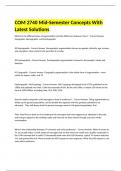Exam (elaborations)
COM 2740 Mid-Semester Concepts With Latest Solutions
- Course
- Institution
What are the different types of segmentation and the differences between them? - Correct Answer Geographic, Demographic, and Psychographic #2 Demographic - Correct Answer Demographic segmentation focuses on gender, ethnicity, age, income, and education. More useful in the past than it is today...
[Show more]



